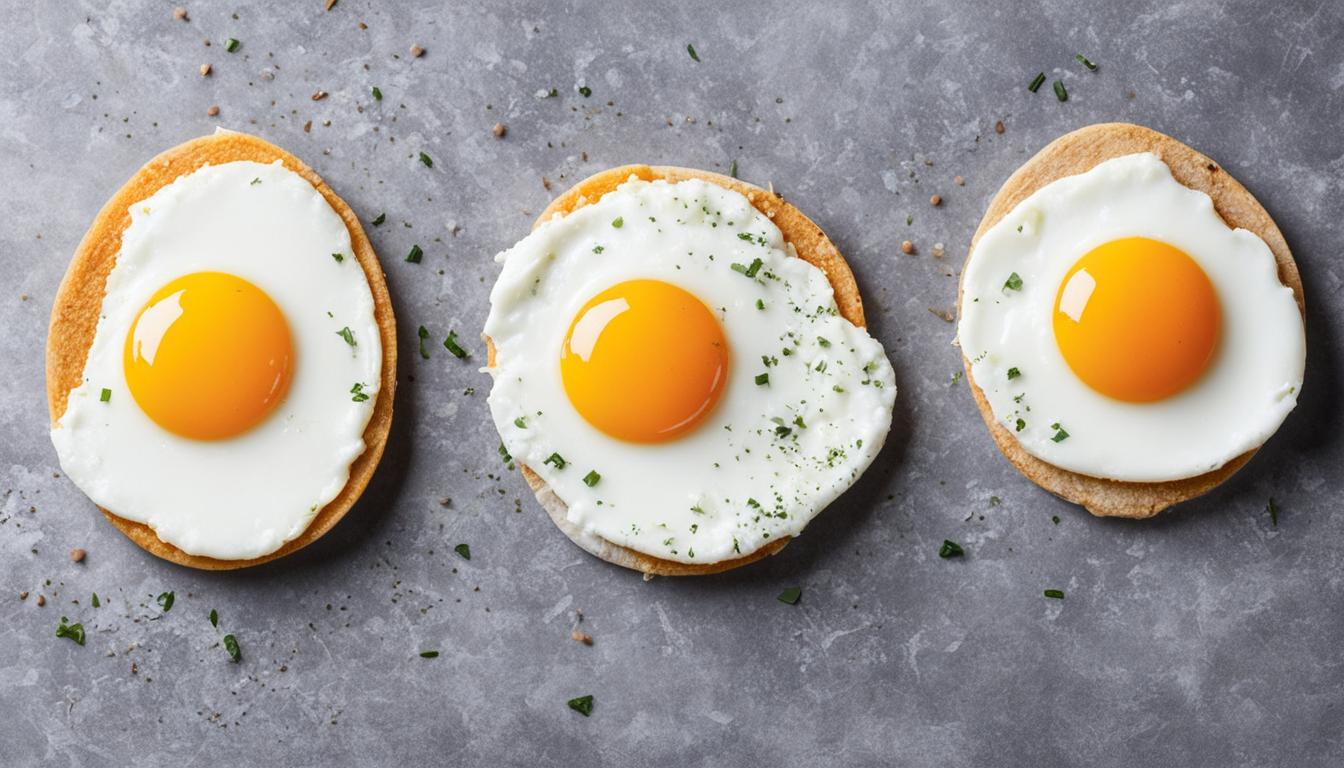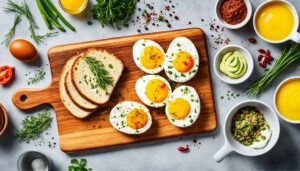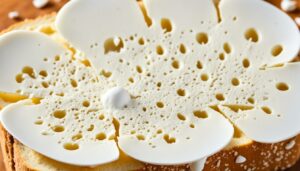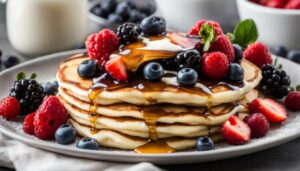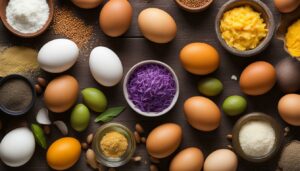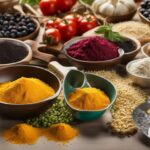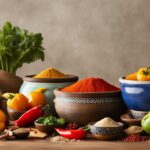When it comes to cooking and baking, eggs are a staple ingredient that plays a crucial role in creating delicious and satisfying dishes. But have you ever wondered what exactly eggs do in a recipe? Let’s explore the importance of eggs in cooking and the various functions they serve in dishes.
Contents
- 1 What’s in an Egg?
- 2 What Eggs Do in Baking Recipes
- 3 The Role of Egg Yolks: Fat
- 4 The Role of Egg Whites: Foam!
- 5 The Role of Whole Eggs: Fat and Foam
- 6 Master the Basics of Egg Science & Safety
- 7 What Do Eggs Do in Baking?
- 8 How Eggs Affect Baking
- 9 Conclusion
- 10 FAQ
- 10.1 What do eggs do in a recipe?
- 10.2 What’s in an egg?
- 10.3 What do eggs do in baking recipes?
- 10.4 What is the role of egg yolks?
- 10.5 What is the role of egg whites?
- 10.6 What is the role of whole eggs?
- 10.7 How should eggs be handled for baking?
- 10.8 How do eggs affect baking?
- 10.9 How do eggs affect the final product in baking?
- 10.10 Why are eggs important in baking?
- 11 Source Links
Key Takeaways:
- Eggs provide structure, texture, and flavor in baking and pastry recipes.
- Understanding the different parts of an egg (whites and yolks) can help in creating successful recipes.
- Egg whites are primarily made up of proteins and water, while yolks are rich in nutrients, vitamins, and fats.
- In baking recipes, eggs serve multiple functions such as providing structure, emulsifying sauces, adding moisture, and acting as a binding agent or glaze.
- The fat content and emulsifying abilities of egg yolks add richness and create smooth batters, custards, and curds.
What’s in an Egg?
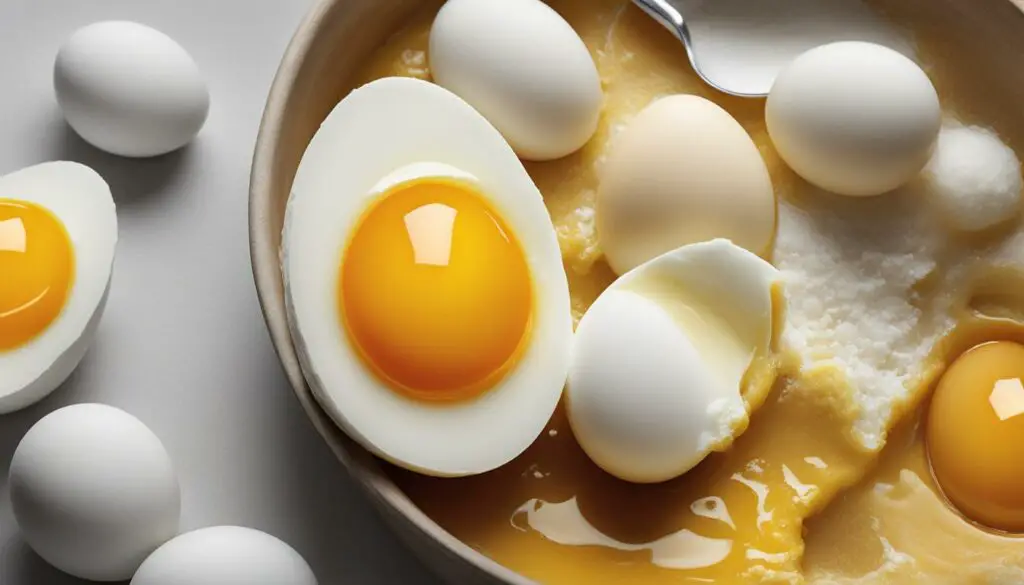
An egg is more than just a shell; it contains different parts that contribute to its composition and culinary versatility.
The two main components of an egg are the egg white and the egg yolk. The egg white, also known as albumen, makes up about 60% of the liquid weight of the egg and contains mostly water and proteins. It serves as a source of nutrition for the developing embryo.
The egg white:
- Rich in proteins and water
- Provides structure and moisture in various recipes
The egg yolk, the vibrant yellow or orange center of the egg, contains essential nutrients, vitamins, and fats. It is densely packed with nutrients that provide nourishment to the developing chick.
The egg yolk:
- Rich in nutrients, vitamins, and fats
- Contributes to the rich flavor and texture of dishes
Within the egg white and yolk, you may notice a thin white strand called the chalazae. The chalazae anchors the yolk to the egg white and the shell, helping to keep everything in place during the cooking process.
To give you a better idea of an egg’s composition, take a look at the approximate weight breakdown of a large-sized egg:
| Egg Component | Approximate Weight (ounce) |
|---|---|
| Egg White | 1 |
| Egg Yolk | 2/3 |
| Shell | A fraction of an ounce |
The composition of an egg, with its distinct parts and their unique properties, contributes to its functionality in various culinary preparations.
What Eggs Do in Baking Recipes
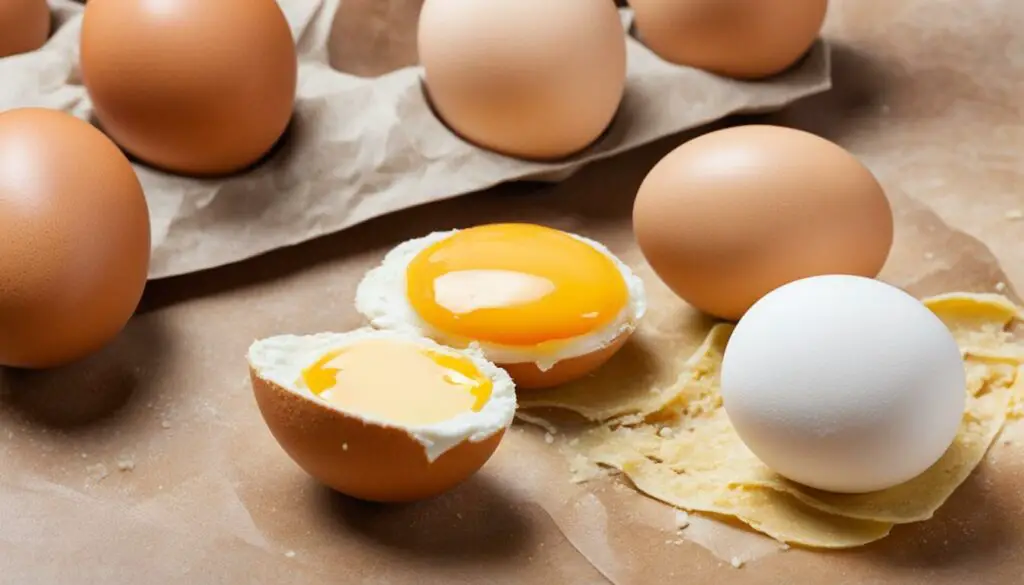
Eggs play a crucial role in the success of baking recipes, performing various functions that contribute to the overall quality and deliciousness of the final product. From providing structure and stability to adding moisture and acting as a binding agent, eggs are truly versatile ingredients in the baking world.
In batter recipes, eggs act as a thickener, helping to create a smooth and cohesive mixture. They provide the necessary viscosity to bind the ingredients together and create a consistent texture in the batter. Without eggs, the batter may become too thin and fail to hold its shape during baking.
Furthermore, eggs serve as excellent thickeners in sauces and custards. When heated, the proteins in eggs coagulate to create a thickened consistency and add a velvety smoothness to these culinary creations.
But the functions of eggs in baking go beyond thickening. They also act as “glue” by binding ingredients together and ensuring that the final product holds its shape. This is especially important in recipes like meatloaf or meatballs, where eggs help to prevent the mixture from falling apart during cooking.
Additionally, eggs can be used as a glaze to add a beautiful shine and color to baked goods. Applying an egg wash on top of bread, pastries, or cookies before baking creates an enticing golden crust that enhances the visual appeal of the final product.
The specific role that eggs play in a recipe may vary depending on whether you use the whole egg, the egg white, or the egg yolk. Each component brings its own unique set of functions and properties to the mix, allowing for endless possibilities in baking.
Eggs truly are a powerhouse ingredient in baking, adding taste, texture, and structure to a wide range of delightful treats. Whether you’re making fluffy cakes, flaky pastries, or creamy custards, eggs are an essential component that shouldn’t be underestimated.
The Role of Egg Yolks: Fat
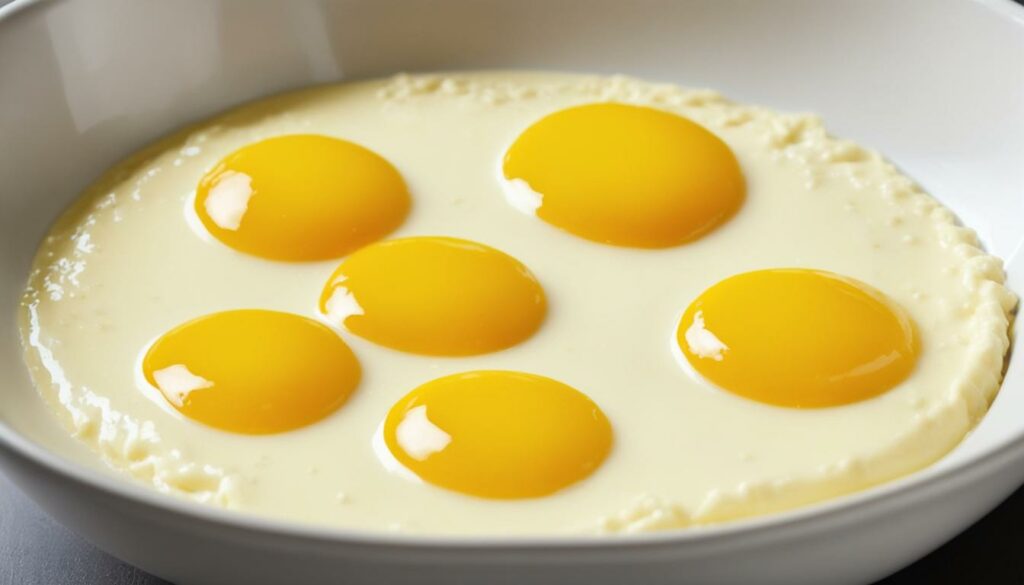
When it comes to baking, egg yolks are an essential ingredient that adds richness and a velvety texture to various baked goods. Their high fat content contributes to the flavor and mouthfeel of desserts, making them a valuable component in creating delicious treats.
Egg yolks play a key role in emulsification, the process of binding liquids and fats together to create a smooth and cohesive mixture. This unique ability of yolks enhances the texture and consistency of batters, custards, pastry creams, and other delectable delights.
One of the remarkable characteristics of egg yolks is their ability to thicken sauces and custards when heated. This property adds depth and richness to these creamy creations, elevating their taste and making them irresistibly smooth.
Uses of Egg Yolks in Baking
Here are some popular culinary applications of egg yolks in the baking realm:
- Creating silky-smooth custards and curds for tarts and pies
- Preparation of velvety pastry creams for eclairs and cream puffs
- Adding richness to cakes, resulting in moist and flavorful slices
The fat content of egg yolks not only enhances the taste and texture of baked goods but also contributes to their overall appearance. The golden hue of certain pastries owes its vibrant color to the presence of egg yolks in the recipe.
The Role of Egg Whites: Foam!
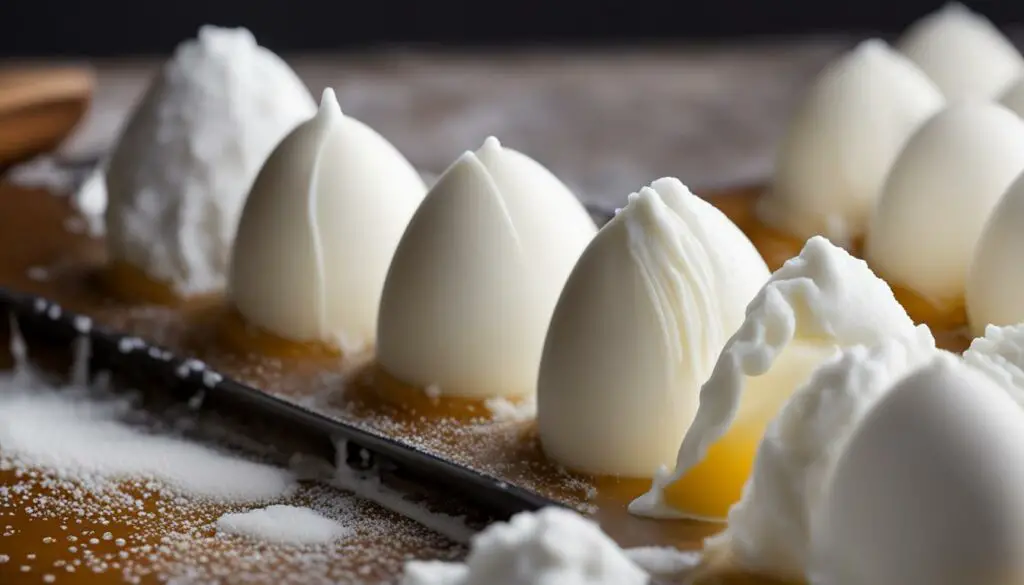
When it comes to baking, egg whites play a unique and important role. By whipping egg whites, you can create a light and airy foam that adds a touch of magic to your desserts. The process of whipping incorporates air bubbles into the egg whites, transforming them into a stable foam that can be used in various recipes.
Whipped egg whites act as a natural leavening agent in baking. As the foam is heated in the oven, the air bubbles expand, causing the recipe to rise and creating a light and fluffy texture. This leavening effect is particularly beneficial in recipes that require a delicate and airy structure, such as soufflés or sponge cakes.
To stabilize whipped egg whites and ensure they maintain their structure, sugar can be added. This addition helps create a crunchy meringue, perfect for topping pies or creating decorative elements for desserts.
In summary, egg whites in baking play a crucial role in creating foam and incorporating air bubbles. This makes them an essential leavening agent that contributes to the lightness and texture of various baked goods. Whether you’re making meringue or creating a soufflé, whipped egg whites are a key ingredient that adds an extra touch of magic to your culinary creations.
| Benefits of Whipped Egg Whites: |
|---|
| Egg whites create a stable foam with air bubbles |
| Act as a natural leavening agent, causing recipes to rise |
| Stabilize with sugar for crunchy meringue |
The Role of Whole Eggs: Fat and Foam

In baking recipes, whole eggs play a crucial role by combining the properties of both yolks and whites. They act as a binding agent, providing structure and support to delicate desserts and pastries. This makes them an essential component in creating delectable and visually appealing baked goods.
Whole eggs serve as a binding agent, providing structure and support to delicate desserts and pastries.
When whole eggs are mixed with sugar, they help trap and hold air, contributing to the lightness and lift of baked goods. This process creates a tender and airy texture that enhances the overall eating experience.
Whole eggs, when combined with sugar, help trap and hold air, contributing to the lightness and lift of baked goods.
Recipes that make use of both yolks and whipped whites, such as chiffon cakes and soufflés, benefit from the best of both worlds. The yolks add richness and fat content, creating a velvety texture, while the whipped whites provide a foam-like structure that adds lightness and volume to the final product.
The combination of yolks and whipped whites in recipes like chiffon cakes and soufflés results in a dessert with a perfect balance of texture and flavor.
| Role of Whole Eggs in Baking | Description |
|---|---|
| Binding Agent | Whole eggs provide structure and support to delicate desserts and pastries. |
| Tenderizing | Whole eggs add moisture and tenderness to baked goods. |
| Light Texture | When combined with sugar, whole eggs contribute to the lightness and lift of baked goods. |
Master the Basics of Egg Science & Safety
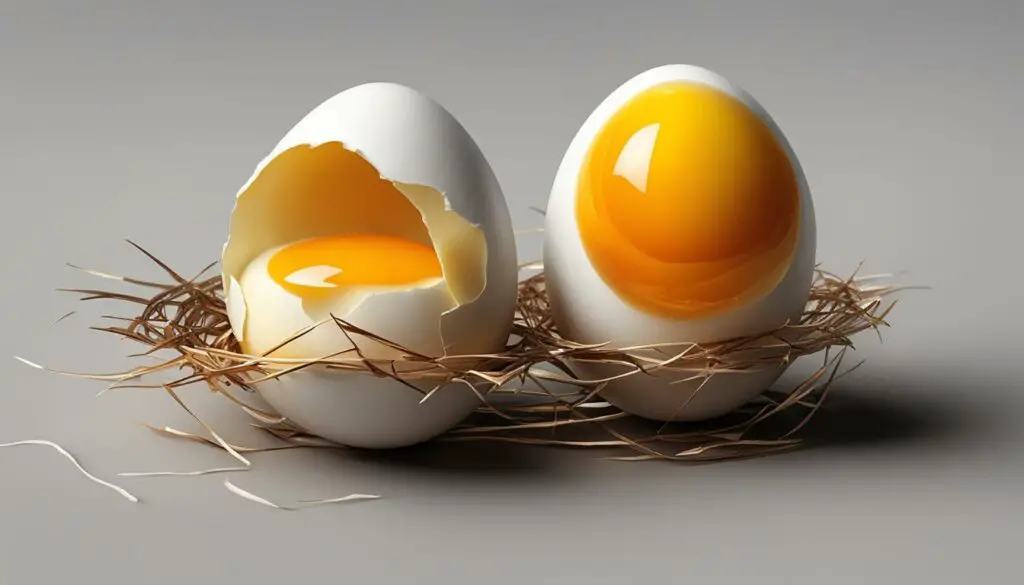
Understanding how eggs cook involves knowing about egg coagulation. When eggs are exposed to heat, the proteins in them begin to solidify, leading to coagulation. Overcooking eggs can result in curdled and grainy textures, affecting the overall quality of your dish.
In cooking eggs, it’s important to consider the egg temperature and safety precautions. Room temperature eggs are often preferred in baking recipes because they tend to emulsify and bind better. However, when it comes to safety, high-risk groups such as pregnant women, young children, and the elderly should avoid dishes containing raw or undercooked eggs.
Here are some key tips to ensure egg safety:
- Handle eggs with clean hands and avoid cross-contamination with other foods.
- Check for egg cracks before using them. Cracking eggs on a flat surface or the inside wall of a mixing bowl can help prevent small shell fragments from entering the mixture.
- Store eggs in the refrigerator at a temperature of 40°F (4°C) or below to prevent bacterial growth.
- When cooking eggs, ensure they reach a safe internal temperature of 160°F (71°C) to kill any potential bacteria.
“Safety in handling and cooking eggs is essential to prevent foodborne illnesses. It’s important to be aware of the risks associated with eggs and to follow proper cooking procedures to ensure a safe and enjoyable meal.” – Egg Safety Specialist from XYZ organization
To summarize, mastering the basics of egg science and safety is crucial for cooking with eggs. Understanding the process of egg coagulation, handling eggs safely, and cooking them to the appropriate temperature can help you create delicious and safe meals for yourself and others.
What Do Eggs Do in Baking?
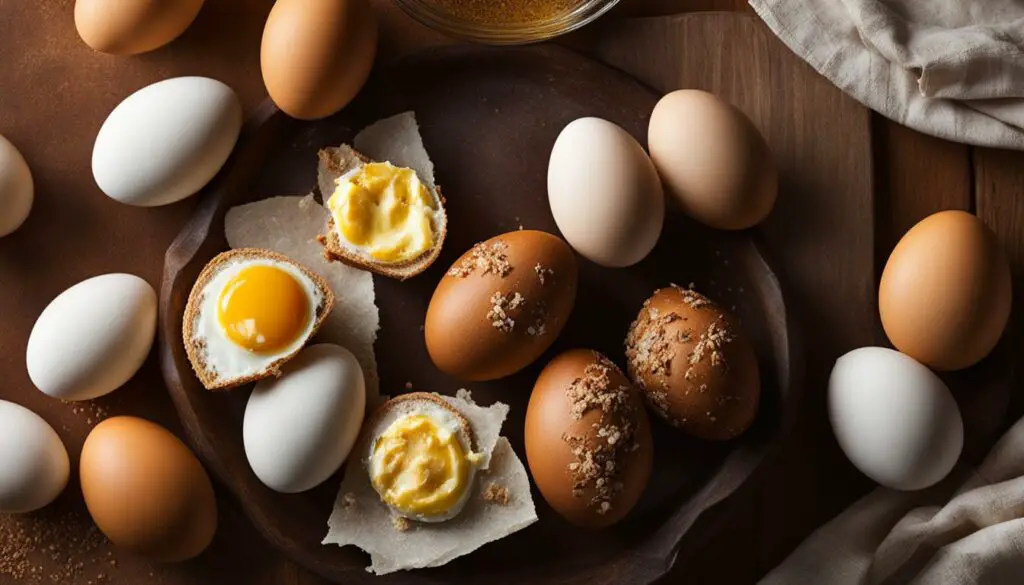
Eggs play a crucial role in baking, contributing to the overall structure, moisture, texture, and flavor of baked goods. Let’s explore the various roles that eggs fulfill in the baking process.
Structure and Binding
Eggs act as a binding agent, providing stability and structure to baked goods. The proteins in eggs coagulate during baking, creating a solid network that supports the other ingredients. This structure helps the baked goods hold their shape and prevents them from crumbling.
Emulsification
Eggs are excellent emulsifiers, meaning they can evenly blend ingredients that would otherwise separate, such as oil and water. This emulsification process creates a smooth batter, enhancing the texture and consistency of the final product.
Leavening
Whipped egg whites are known for their ability to incorporate air and create foam. This foam acts as a natural leavening agent, causing the batter to rise when baked. The air bubbles trapped within the whipped egg whites expand in the oven, resulting in light and fluffy baked goods.
Richness and Flavor
Egg yolks are the source of richness and flavor in baked goods. The fat content in the yolks adds a luscious and velvety texture, making the final product more indulgent. Additionally, the proteins and nutrients in the yolks contribute to the overall flavor profile of the baked goods.
Color
Eggs also contribute to the color of baked goods. As they bake, the proteins in the egg whites and yolks undergo Maillard browning, resulting in a golden brown hue. This desirable color adds visual appeal to cakes, cookies, and other baked treats.
| Egg Function | Description |
|---|---|
| Structure and Binding | Provides stability and structure to baked goods, preventing them from crumbling. |
| Emulsification | Evenly blends ingredients and creates a smooth batter. |
| Leavening | Whipped egg whites incorporate air and create foam, resulting in a light and airy texture. |
| Richness and Flavor | Yolks add richness, flavor, and a velvety texture to baked goods. |
| Color | Contributes to the golden brown hue of the baked goods during the Maillard browning process. |
Understanding the various roles of eggs in baking allows you to harness their unique properties and create delicious and successful baked goods.
How Eggs Affect Baking
Eggs play a crucial role in baking, influencing various aspects of the final product. From providing structure to adding moisture and contributing to the desired color, eggs are a versatile ingredient that impacts the overall quality of baked goods.
Let’s explore the effects of eggs in baking:
Structure through Protein Coagulation
When exposed to heat, the proteins in eggs undergo coagulation, resulting in the solidification of the batter or dough. This protein coagulation provides stability and structure to baked goods, ensuring they hold their shape during baking.
Aiding Emulsification
Eggs have emulsifying properties, which means they can help blend and stabilize fat and water-based ingredients. In baking, eggs act as emulsifiers, creating a smooth and cohesive batter or dough, resulting in a uniform texture and improved flavor.
Leavening Agent
Although not as prominent as other leaveners like baking powder or yeast, eggs also contribute to the leavening process in baking. When beaten or whipped, eggs incorporate air, creating pockets of gas that expand during baking, resulting in a light and airy texture. This leavening action is particularly notable when using whipped egg whites, as they can create fluffy meringue toppings or soufflés.
Shortening Action for Tenderness and Flakiness
Shortening refers to the action of fat in creating tenderness and flakiness in baked goods. The fat content in eggs, primarily found in the yolks, contributes to the shortening of the dough or batter. This results in tender and delicate textures in cookies, pastries, and cakes.
Moisture Content
Eggs are a source of moisture in baking recipes. As they contribute liquid content to the batter or dough, they help prevent baked goods from becoming dry or excessively crumbly.
Achieving Desired Color
In addition to adding moisture, eggs also contribute to the color development of baked goods. The proteins in eggs undergo Maillard reactions during baking, resulting in the desired golden brown color on the surface of bread, cakes, and pastries.
Understanding the effects of eggs in baking is crucial for achieving the desired texture, structure, and flavor in your baked creations.
| Effects | Description |
|---|---|
| Structure | Protein coagulation provides stability and structure to baked goods. |
| Emulsification | Eggs act as emulsifiers, creating a smooth and cohesive batter or dough. |
| Leavening Agent | Eggs contribute to the leavening process, creating a light and airy texture in baked goods. |
| Shortening Action | Fat content in eggs adds tenderness and flakiness to baked goods. |
| Moisture | Eggs contribute to the moisture content of baked goods, preventing dryness. |
| Color | Eggs contribute to the desired golden brown color on the surface of baked goods. |
Conclusion
In summary, eggs are a vital and versatile ingredient in baking. They play a crucial role in creating the structure, moisture, texture, and flavor of baked goods. By understanding the functions of eggs in recipes, bakers gain greater control and can unleash their creativity in the kitchen.
Whether used as a binding agent, a leavening agent, an emulsifier, or for their richness, eggs contribute unique properties that enhance the quality of baked goods. Their ability to create stable foams, provide stability to batters, and add moisture to cakes and pastries makes them an indispensable ingredient for achieving delicious results.
From creating light and airy meringues to producing smooth custard fillings, eggs offer endless possibilities for baking enthusiasts and professionals alike. With their significant impact on the final product’s structure, moisture, texture, and color, it’s clear that eggs are an essential component in culinary preparations. So next time you’re baking, remember to appreciate the important role that eggs play in creating your favorite treats.
FAQ
What do eggs do in a recipe?
Eggs play a vital role in baking and pastry, providing structure, texture, and flavor. They contribute to the overall structure of baked goods, act as a binding agent, provide stability, and add moisture. Eggs also aid in emulsification and act as a leavening agent, creating a light and airy texture. The fat content in egg yolks enhances richness and flavor, while the water content affects the moisture levels. Eggs also contribute to the color of baked goods, achieving a golden brown hue.
What’s in an egg?
An egg consists of an egg white and a yolk. The egg white is primarily made up of proteins and water, while the yolk is rich in nutrients, vitamins, and fats. The chalazae is a thin white strand that anchors the yolk to the egg white and the shell. The composition of a large egg is approximately 1 ounce for the white, 2/3 ounce for the yolk, and a fraction of an ounce for the shell.
What do eggs do in baking recipes?
Eggs serve multiple functions in baking recipes. They provide structure and stability to batters, helping to thicken and emulsify sauces and custards. Eggs also add moisture to cakes and other baked goods, and can act as a binding agent or glaze. The specific role of eggs can vary depending on the recipe and their contribution may overlap with the functions of egg whites, yolks, or whole eggs.
What is the role of egg yolks?
Egg yolks are used in baking for their fat content and emulsifying abilities. They add richness and a velvety texture to baked goods. The unique ability of yolks to bind liquids and fats together creates an emulsion, resulting in smooth batters, satiny custards, and creamy curds. Heated yolks can also thicken sauces and custards, enhancing their texture.
What is the role of egg whites?
When whipped, egg whites incorporate air bubbles, creating a stable foam that can be used for meringues and soufflés. The whipped egg whites act as a natural leavening agent, causing recipes to rise in the oven. Sugar can be added to stabilize the whipped egg whites, allowing for the creation of crunchy meringue and other airy desserts.
What is the role of whole eggs?
Whole eggs combine the properties of both yolks and whites in baking recipes. They act as binding agents, providing structure and support to delicate desserts and pastries. Whole eggs also help trap and hold air when mixed with sugar, contributing to the lightness and lift of baked goods. Recipes that use both yolks and whipped whites, such as chiffon cakes and soufflés, benefit from the best of both worlds.
How should eggs be handled for baking?
Eggs should be handled safely, especially when serving them to high-risk groups. Cracking eggs on a flat surface or the inside wall of a mixing bowl helps prevent small shell fragments from entering the mixture. Room temperature eggs are often preferred in baking recipes to ensure better emulsification and binding.
How do eggs affect baking?
Eggs have significant effects on baking, including providing structure through protein coagulation, aiding emulsification, and acting as a leavening agent. They also contribute to shortening, adding tenderness and flakiness to baked goods. The water content in eggs affects moisture levels, and eggs can help achieve desirable color in the final product.
How do eggs affect the final product in baking?
Eggs contribute to the structure, moisture, texture, flavor, and color of baked goods. They provide structure through protein coagulation, act as a binding agent and emulsifier, and can create a light and airy texture when whipped. The fat content in egg yolks adds richness and flavor, while the water content affects moisture levels. Eggs also help achieve a desirable golden brown color in the final product.
Why are eggs important in baking?
Eggs play a crucial role in baking, contributing to the overall structure, moisture, texture, and flavor of baked goods. They have unique properties that can be utilized in various baking techniques. Understanding the functions of eggs in recipes allows for greater control and creativity in the kitchen. Eggs are an essential and versatile ingredient in culinary preparations.

